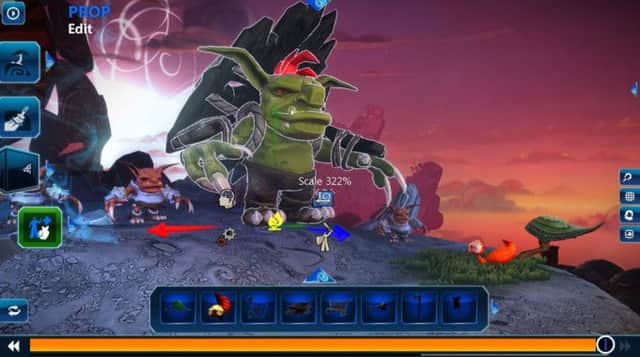The Scotsman Games review: Project Spark


Project Spark
Platform: Xbox One (reviewed) / PC
Score: 8/10
AT a time when the shelves of game retailers and digital marketplaces are becoming increasingly cluttered with blockbuster titles that cost hundreds of millions of pounds to develop, Project Spark offers up an unlikely alternative. Rather than taking a passive role in playing a triple A title, it presents players with the opportunity to create their own games, whether they be 3D action adventures or, should you invest in the £30 that expands your tools and themes beyond the basic, free version, something considerably more ambitious.
On an Xbox One controller, the multitude of options makes for a busy yet relatively intuitive control system and there is a tremendous immediacy in overseeing the genesis of your unique world, with a few deft button presses raising a mountain from the ground or peppering a desolate terrain with a cluster of trees. Assigning specific properties to assets takes the form of selecting logic sentences and conditional statements that will feel vaguely familiar to those with some experience of 1980s bedroom coding.
Advertisement
Hide AdAdvertisement
Hide AdCreating a simple game is gratifying although expanding it requires graft
Indeed, it will not be long before you have created your own mini world, complete with a protagonist, enemy and end goal or collectable. Such a realm may be cursory, but knowing that you have forged it in accordance with your own whims and fancies is a gratifying experience and gives you an appetite to explore further. Granted, expanding your game beyond these basic building blocks to establish a more comprehensive entity requires you to delve deeper, a daunting prospect to those with no programming knowledge.
Yet wielding that determination to fully invest yourself in the game is essential to getting the most out of Project Spark. This is not a title you can dip in and out of every week or so, not least for the fact that its complex menu layout and user interface requires several hours of repeated use before it slowly becomes familiar. The game will take you by the hand and try to lead you step by step, with tutorials that are, for the most part, reasonably lucid. But they only take you so far, and even the most dedicated users will need outside assistance; on several occasions, we resorted to following online guides and snapping YouTube videos to the side of our game screen on Xbox One.
It lets you peek below the surface of games you enjoy to see how they are made
Another way - and one that is infinitely more satisfying - is to team up with a friend and mould a game together. This co-operative element is an excellent way of learning on the job and the likelihood is both players will learn from another as their respective skills and visions slowly coalesce into something tangible. Granted, the majority of people on your friends list will no doubt be too busy playing the latest FPS release, but if you can find a willing buddy, it makes Project Spark a blast.
Fortunately for those flying solo, inspiration is close to hand in the form of other games created by players, some of which exhibit lovely and downright off the wall ideas. You can play them or - cleverly - use them as templates for your own game courtesy of what Project Spark describes as ‘remixing’. It may not result in a truly unique title, but it allows you establish what you like and dislike in a game and peek beneath the surface to see how it was constructed.
At a time when the likes of Minecraft and Terraria are demonstrating how play and creativity can happily co-exist in the one title, Project Spark is a clever and compelling way of introducing elementary coding to the masses. It takes time to get the best out of it, but when your world, characters and mechanics all click, it gives you a renewed appreciation of just how hard it is to create something you will come back to time and again.
TIPS AND TRICKS:
1) Coding the brains of characters and assets in Project Spark - known as ‘koding’ - is difficult to master so to begin with make use of the preset options and learn from how they interact with the environment.
Advertisement
Hide AdAdvertisement
Hide Ad2) Tempting as it may be to plough ahead and tinker with your world for hours on end, remember and test often and regularly. Chances are you will find a hiccup in the design that needs to be fixed.
3) If in doubt, search on YouTube for tutorials. The Project Spark community is eager to share its knowledge and watching videos is the best way to pick up new skills.